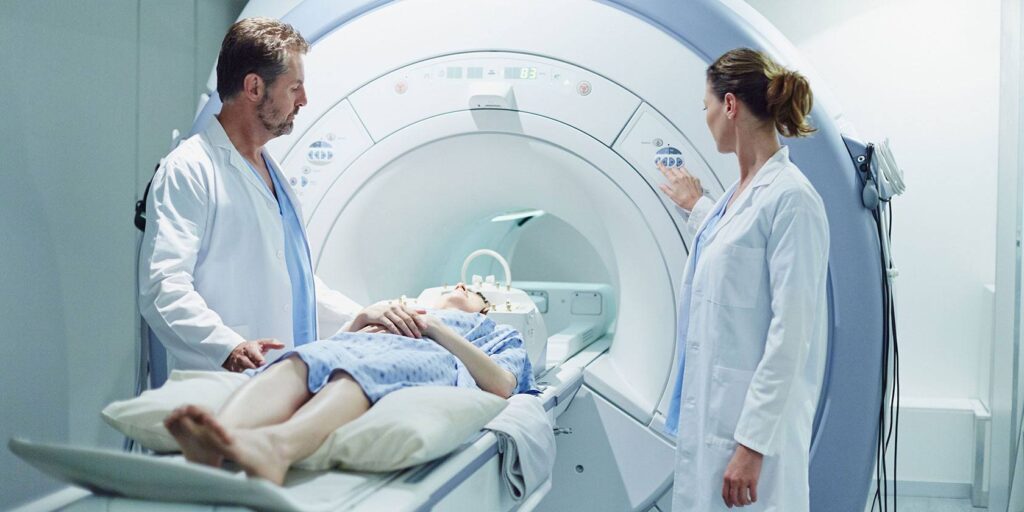
A patient is prepared for an MRI scan of the brain. A painless, non-invasive procedure, MRI (Magnetic Resonance Imaging) technology uses strong magnetic fields that force alignment of protons in the tissues to produce a 3D map of the brain. Image: irst Look MRI
By James Myers
Technology holds great promise for human health in the development of new medications and treatments, diagnosing illnesses, bodily rehabilitation, and delivery of treatment. This edition of The Quantum Record reports on recent exciting developments in a number of these areas that promise a bright future for humans to flourish.
But human flourishing doesn’t depend solely on our bodily health. The body is controlled by the mind, and our technological priorities should reflect the crucial imperative of protecting both the physical brain and the brain’s mental functions.
The first step in safeguarding all that our minds do for us is to understand and address the full scope of threats to the brain’s physical health and its imaginative capacity.
Heat is a threat to the brain, and August, 2023 was the hottest August globally in the 174 years that the U.S. National Oceanic and Atmospheric Administration (NOAA) has maintained climate records. In 2023, record-breaking heatwave events struck in South America, Europe, Asia, Africa, and North America where smoke from wildfires blanketed large areas of the continent for weeks. As average daily temperatures reached historic highs, Time Magazine reported on the effects of heat on the brain and mental health, which include loss of sleep and memory, inability to focus, irritability, and depression.
Extreme heat events are on the increase globally, and the consequences can be severe for individuals with other brain issues such as bipolar disorders, where heat can trigger manic episodes. Some studies have correlated a one degree increase in temperature to a 1% increase in suicides, and life-threatening heat stroke occurs when the body’s core temperature reaches 40 degrees Celsius.
With the stresses of heat and pollution, climate change poses a potentially significant threat to our brain health. It’s a threat few are studying, and it attracts little attention in international forums like the United Nations COP28 climate summit that began on November 29, 2023.
We discussed the range of known and potential effects of climate change on the brain with neuroscientist Dr. Burcin Ikiz in The Quantum Feedback Loop podcast. Dr. Ikiz’s newly-launched EcoNeuro venture promises to bring the issues to the forefront for action.
As Dr. Ikiz notes, understanding a neurological threat like climate change is difficult because the damage can accumulate over many years until, all of a sudden, it reaches a “point of no return.” That is a point we would never want to reach, for ourselves and most certainly not for the children and future generations who depend on us.
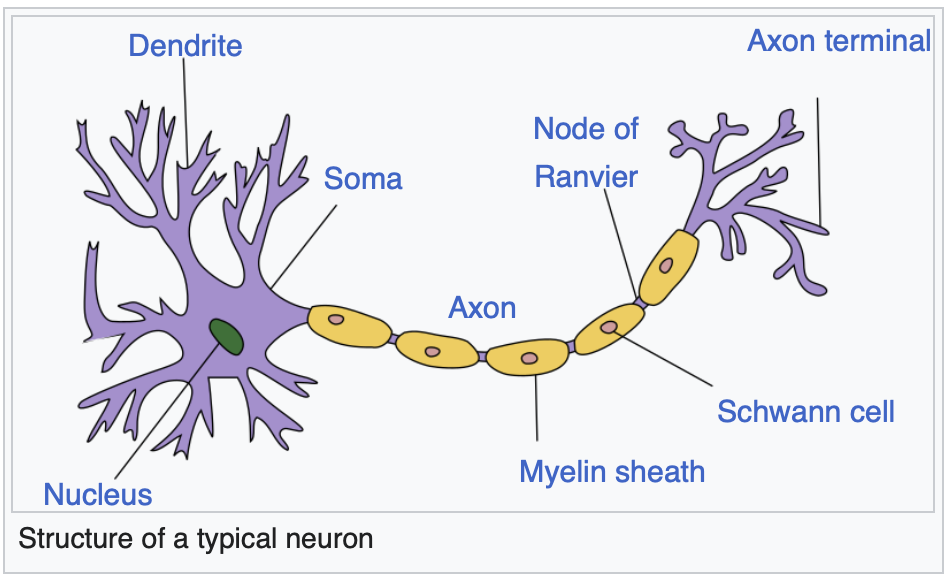
There are 860,000,000,000 neurons in the average adult human brain; a frog, for comparison, has 54,000 times fewer. Each neuron is part of an incredibly complex system that transmits signals across synapses in the brain electrically and chemically. Image: Wikipedia
In the face of a brain challenge like climate change, technology has the potential to do much good – but only if priorities shift from polluting technologies to clean technologies.
A recent feature in The Quantum Record reported on some of the exciting developments in technologies that help to remediate environmental damage, for example from oil spills and plastic pollution. Progress is being made, but polluting technologies still predominate.
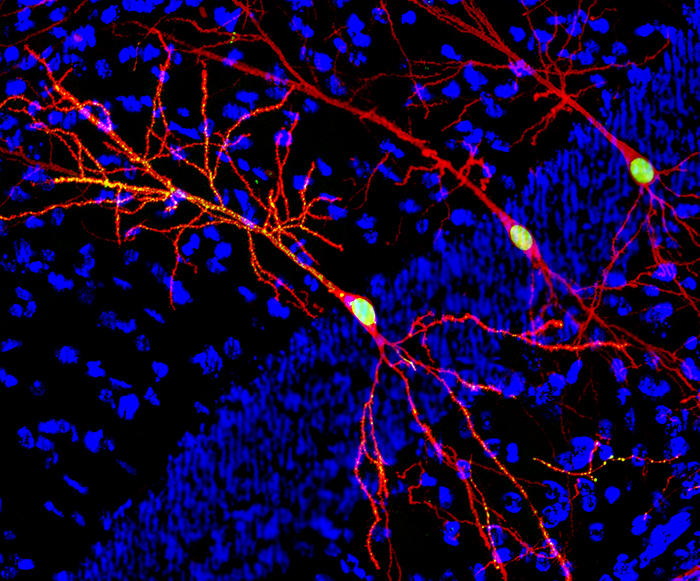
A cross-section through the brain’s hippocampus, with the cell bodies stained in blue. Neuron membranes are in red, and active presynaptic boutons and the cell nuclei in green. Image by Rodrigo Suarez, Queensland Brain Institute.
Technology is Expanding Knowledge of the Brain’s Physical Operation
There remains much to be discovered about the physical operation of the brain and its mechanisms, warranting further caution to protect the full nervous system while our knowledge of it remains incomplete. Technology is, however, opening new windows to understanding the complexity of the trillions of connections in our brains and their effects on the body.
Take, for instance, the glial cells that comprise the majority of tissue in our brain and spinal cord. As Dr. Shai Shaham, professor of cell biology at The Rockefeller University, told Quanta Magazine in 2020, “In the human brain, glial cells are as abundant as neurons are. Yet we know orders of magnitude less about what they do than we know about the neurons.”
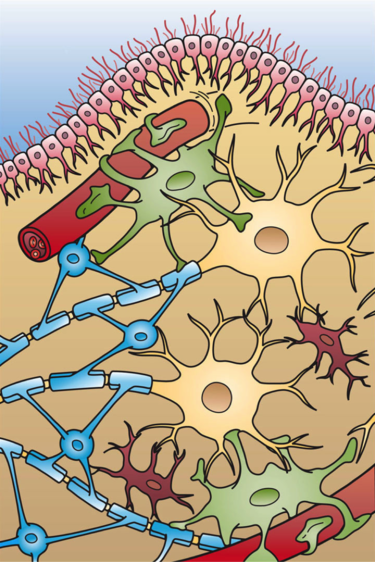
The functions of the brain’s glial cells are not yet fully known. There are four different types of glial cells in our nervous system consisting of the brain and spinal cord: ependymal cells (light pink), astrocytes (green), microglial cells (dark red) and oligodendrocytes (light blue). Image: Wikipedia
Only three years ago, scientists uncovered a specialized type of glial cell that transmits pain signals from the skin to the brain.
Once thought to exist only for the protection of neurons, glial cells are now known to perform a vast array of critical functions including memory processing, neuronal communication, and assisting in brain development and the immune system.
Glial cells also operate in the gut, and recent studies have shown their operations include digestion, nutrient absorption, blood flow and immune responses. Science has increasingly focussed on the connection between the brain and the gut microbiome, establishing the influence of gut and intestinal health on rheumatoid arthritis, Alzheimer’s disease, asthma, autism spectrum disorders, and other systemic conditions.
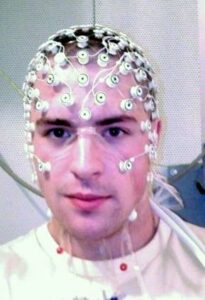
Electrodes are placed on a patient’s head for an electroencephalograph (EEG) to measure the brain’s electrical activity. While medical capabilities and technologies continue their rapid advance, much remains to be discovered about brain conditions and treatments. Cellphone photo by Douglas Myers, from Wikipedia.
The Influence of Technology on Mental Health
The brain’s mental and imaginative functions are, of course, critical to our ability to navigate an increasingly technological world with the choices that we make. Special care is required to ensure that technology does not interfere with our capacity for perception and mental wellbeing.
Concern is developing about the consequences of the unregulated proliferation of mental health apps. Vice recently reported on a Belgian man whose interactions with a mental health chatbot led to his suicide. Issues continue to exist with AI bias and discrimination in sensitive applications, since the training data is predominantly drawn from wealthier white people and does not reflect the realities of vast portions of the world’s population.

NPR reported on hearings held on the effects of social media messaging from a national leader, which many claim contributed to a riot over an election result.
The negative effects of social media technologies on mental wellbeing and the brain’s imaginative capacity have been widely studied and reported for years.
There is little doubt that social media has a share of responsibility for not only increasing suicide rates, but also political polarization across the planet. Passions can be inflamed instantly with a tweet or group chat message that travels at light speed to millions of people, without time for reflection.

The structure of the brain has fascinated scientists for centuries. Leonardo da Vinci’s anatomical studies included the brain and he created this image circa 1508-1509 after injecting molten wax into the brain to determine the shape of its internal cavities. Image: Royal Collection Trust
Polarization and hate are, most would agree, not generally beneficial for mental wellbeing.
The potential consequences of polarization have become a national security issue for many countries, to the extent that the United States Department of Defense has launched the Social Simulation for Evaluating Online Messaging Campaigns (SocialSim) to study the spread of information and misinformation.
A recent feature in The Quantum Record quoted an AI scientist contributing to SocialSim that highlights the severe threat to the mind’s behavioural and imaginative functions from technological abuse of our data:
“Massive amounts of data are available on our activities, and this data is a commodity that is widely available. (…) This means that if this data is useful, our adversaries can (…) learn a lot about our behavior, creating opportunity for foreign influence. My existential fear is that with increased AI capabilities, foreign governments that don’t share our values about freedom of speech and the right to privacy will be able to understand human behavior better than anybody else. And, so it’s no longer an arms race, it’s a behavioral science race.” – Dr. Jonathan Pfautz, Chief AI Scientist at Leidos

OpenAI CEO Sam Altman (whose control of the company was terminated and reinstated over the course of a week in November) signs a partnership agreement to expand the use of generative AI in the United Arab Emirates and other regions. The New York Times reported on connections between the UAE’s G42 and a foreign superpower, raising the possibility of foreign manipulation of generative AI users. Image: Gary Marcus
The World Health Organization (WHO) reports that depression is one of the leading causes of disability, and suicide is the fourth leading cause of death among 15-29-year-olds.
Lancet Global Health reported a WHO global study that estimated spending on mental health comprised only 2% of government healthcare budgets globally in 2017, a priority that may need to be increased in the face of technological challenges.
The Lancet report also notes that “for every $1 invested in scaled-up treatment for depression and anxiety, there is a $4 return in better health and productivity,” making the case for increased investment that will pay economic dividends in the future. For any of us who have worked in jobs that tax our mental wellbeing, it’s not difficult to imagine the significance of the potential dividend.
There are, however, many challenges to overcome in reducing environmental and other threats to brain health and mental wellbeing. Private sector economics and uncertainty are among the hurdles to making further necessary long-term investments in beneficial technologies, and international cooperation of governments and other public bodies is needed to define the full scope of the issues and realign priorities.
Technology alone won’t provide the solutions.
For instance, while technology and research have made life-saving HIV medications widely available in wealthier countries for several decades, according to UNAIDS, 24% of the world’s infected population still receive no treatment. Public sector initiatives like the U.S. President’s Emergency Plan for AIDS Relief (PEPFAR) prove the benefits of international cooperation, with an investment of $100 billion since its launch in 2003 that has saved an estimated 25 million lives.
A combination of technology and public action will help to ensure the safeguarding of our physical brains and their mental functions. Given the prime importance of our brains for survival, which is literally self-evident, mental wellbeing deserves high ranking in our technological priorities.
The potential of well nurtured and protected minds is quite possibly limitless. Imagine, for example, the fantastic innovations in clean technology that would emerge if the brainpower of 7.8 billion humans were applied to the challenge. In the final analysis, the problem may simply be one of our state of mind toward the future.



